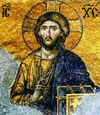| Ecumenical Patriarchate | |
| Founder | St. Demetrios |
| Independence | Sept 3174 from Caliphate |
| Recognition | Orthodox Church |
| Primate | Archbishop of Auronopolis-Nea Beretea and Ecumenical Patriarch Konstantinos VII |
| Headquarters | Auronopolis |
| Territory | Ruthenia, Thracia and Mount Agios |
| Language | Hellene, Mauryan, Slavinian, English, Latin |
| Population | 30.000.000 aprox. |
| Bishops | 125 |
| Priests | 8,515 |
| Parishes | 662 |
| Monastics | 3,541 |
| Monasteries | 541 |
The Ecumenical Patriarchate of Auronopolis (: Οἰκουμενικὸν Πατριαρχεῖον Aωνσταντινουπόλεως, Oikoumenikòn Patriarcheîon Auronopoleion, "Ruthenian Orthodox Patriarchate"), part of the wider Orthodox Church, is one of the two autocephalous churches within the communion of Orthodox Christianity. It is headed by the Ecumenical Patriarch of Constantinople, currently Konstantinos VII Because of its historical role as the Mother Church of most modern Orthodox churches, the Ecumenical Patriarchate has enjoyed the status of "Primus inter pares (first among equals)" among the world's Orthodox prelates.
History[]
Birth of the Patriarchate[]
Orthodoxy between the Ruthene people existed since the Archaic period, when the city of Hispales and the pilgrimage of St. Hellena to other Rothinoi city states of the peninsula and Mount Agios, the first cathedral installed in the peninsula was in Hispales and Tortossa, the orthodox church was gradually installed by believers and being confused by other pagan religions and cults under Sabaria and other cities as Volossia.
After the Korimi conquest of the Rothinoi Peninsula the orthodoxy gains power between the Korimi people, the coronation of St. Stephanos and the consolidation of the Kormenian people as the protectors of the orthodoxy creating the Kormenian Kingdom, unifying the Rothoi states and the religion, being crowned as "Rex of Kormenicorum, protector of the church", being the first orthodox king and the first king of Kormenia, Stephanos created the first Patriarchate of the peninsula in Beretea in the year 1000.
Similarly many bishops and archbishops served intellectually and religiously to the monarch , assisting in the development of legislation , the process of Christianization and management and development of moral and social order. Names of those bishops and archbishops who were being still remain the most important : Blessed Sebastianos of Beretea , St. Athanasius , St. Berilios , San Buldus , San Beneteas , San Gerardos, among others.
St. Stephanos promoted the construction of numerous abbeys , cloisters , monasteries and churches and ended others, for example, Pannonhalma Abbey , whose construction was initiated by Prince Álmos . The most significant building was the Basilica of Atenelis that was so big it could hold 9000 people. This became the Basilica of Kormenian coronation and where buried nearly three dozen Kormenian monarchs.
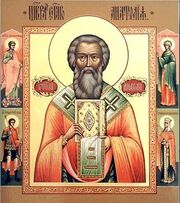
St. Demetrios was the first Ecumenical Patriarch installed in Beretea
With the development of the hierarchical structure of the Church, the bishop of Beretea came to be styled as exarch (a position superior to metropolitan). Beretea was recognized as the first Patriarchate in the Great Council of Beretea in 1021 appointed by elections of bishops of every church in the country.
Because of the importance of the position of Beretea church at the center of the Kormenian community, affairs involving the various churches outside the city direct authority came to be discussed in the new Patriarchate, particularly where the intervention of the Kormenian king was desired. The patriarch naturally became a liaison between the king and bishops traveling to the capital, thus establishing the position of the patriarch as one involving the unity of the whole Church, particularly in the Capital. The patriarch thus came to have the title of Ecumenical, which referenced not a universal episcopacy over other bishops, but rather the position of the patriarch as at the center of the oikoumeni, the "household" of the Kormenian kingdom.
In any case, for almost a thousand years the Patriarch of Beretea presided over the church in the Kingdom of Kormenia and its missionary activity that brought the Christian faith to many peoples north of the Kingdom borders. The cathedral church of Beretea was the center of the orthodox world. The Ecumenical Patriarchate came to be called the "Great Church of Christ" and it was the touchstone and reference point for ecclesiastical affairs in the kingdom, whether in terms of church government, relations with the state, or liturgical matters.
Conquest and Parsian Age[]
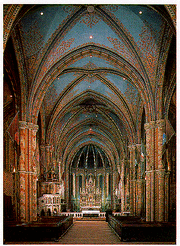
Inside of Hispales Cathedral, Painting of Andronikos Sgouros
After the Conquest of primitive romans, the Patriarchate came to care more directly for all the Orthodox living in the Parsian Empire. The Sultan dissolved the Patriarchate and formed the Parsian Caliphate as their espiritual succesor, the abolished institution maintain his importance in Mauria and the Patriarch becomes a titular title exiled in Mount Agios being the protos of the island the "de facto" leader of the remain orthodoxs in the peninsula
Special restrictions were imposed concerning the construction, the renovation, the size and the usage of the bells in churches. For example, in a town a church should not be larger in size than the largest mosque. Some churches were destroyed (e.g. the Church of the Holy Apostles), many were converted into mosques the Rotunda and Hagios Demetrios in Valatea) or served for other uses (e.g. Hagia Irene in Ostambal, which became an armory for the Military, and the Hagia Theodosia or Christ Euergetes, also in Ostambal, which after the Conquest served for a while as a naval dockyard. Must also be pointed out that such rules, very strict in the beginning, with time and the increasing importance reached in the Parsia Empire by the Emperor's Faith, were more and more disregarded, so that in the late empire of Ostambal there was a veritable building boom of Orthodox churches, many among them having high bell towers and brick domes, which previously were both strictly prohibited, after the Parsian Interregnum, the sultan Mesud III allowed the orthodox workship in the peninsula and later the Patriarchate was allowed again with the supervision of the Caliphate, in 3170 the Patriarchate becomes independient and was installed in Tortossa, the enclave of most Selloi in the peninsula at that time, St. Kallistos granted the consagration in Agia Lavrea.
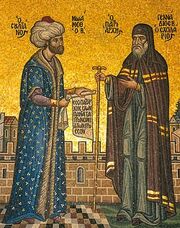
Mesud III and St. Kallistos in the reestablishment of the Patriarchate
Such arrangements were known in orthodox history as the "age of enlightenment" and were now called by the holy St. Kallistos, the Patriarchate was installed in Tortossa, the new place the new Selloi place where believers met together against the new and free patriarchy
As Parsian rule eventually weakened, various parts of the Orthodox Church that had been under the direct influence of the Ecumenical Patriarchate came to be independence, before the Enosis the Patriarchate installed in the Church of Saint Ioannes in the Fallar district of Ostambal, after the Battle of Ostambal and liberation of the Ruthenes, the Patriarchate installed in Hagia Triada in Auronopolis .
Administration[]
Main Article: Ecumenical Patriarch of Auronopolis
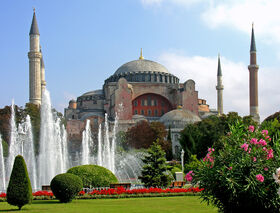
Hagia Mistea, The seat of the Patriarchate of Auronopolis
The affairs of the patriarchate are conducted by the Holy Synod, presided over by the Ecumenical Patriarch. The synod has existed since some time prior to the birth of the church and assists the patriarch in determining the affairs of the possessions under his jurisdiction. The synod first developed from what was referred to as the resident synod, composed of the patriarch, local bishops, and any Orthodox bishops who were visiting in the imperial capital of Auronopolis.
Structure[]
Head of the Patriarchate of Auronopolis and of the Holy Synod is the Archbishop of Auronopolis and Ecumenical Patriarch "first among equals" and Co-Head of State of Mount Agios Konstantinos VII (Dyonisios Mpakalis, 3247-Present). The local churches of the Ecumenical Patriarchate consist of one archdiocese and 18 metropolises, each of which reports directly to the Patriarch of Auronopolis with no intervening authority. In addition, the archiocese have internal metropolises, which are part of their respective archdiocese rather than distinct administrative entities, unlike the other metropolises.
Archdioceses (archbishops and metropolitans)[]
- Archdiocese of Auronopolis and New Beretea: Patriarchal diocese
- Elder Metropolis of Terepesos
- Elder Metropolis of Hispales
- Elder Metropolis of Papandrea
- Elder Metropolis of Skleris
- Elder Metropolis of Korolineia
- Metropolis of Stavrodromion
- Metropolis of Tatavla
- Metropolis of Arromachia
- Metropolis of Hypsomatheia
- Metropolis of Keratius
- Hellenic Archdiocese of Thracia
- Metropolis of Cephalonia
- Metropolis of Korinopolis
- Metropolis of Massambria
- Metropolis of Strymon
- Metropolis of Sasanella
- Metropolis of Abydios
- Metropolis of Grevena
- Metropolis of Santorini
- Archdiocese of Mundari
- Metropolis of Berbengrad
- Metropolis of Morro
- Metropolis of Kellenov
Holy Synod[]
The Holy and Sacred Synod of Auronopolis is presided over by Patriarch of Auronopolis, and is comprised of metropolitans of the patriarchate.
The patriarch or head bishop is elected by a group of bishops called the Holy Synod. For instance, the Holy Synod is a ruling body of the Ecumenical Patriarchate of Auronopolis, and it formulates the rules and regulations regarding matters of church organisation, faith, and order of service, under the de jure presidency of the Ecumenical Patriarch, and consists of the Primate and 12 bishops, each serving for one term on a rotating basis and deals with details of administration.
Notable hierarchs of the Ecumenical Patriarchate are the popular writer Kallistos (Timothy) Ware, an assistant-bishop in the Archdiocese of Thracia, and author of The Orthodox Church, the best-known introduction to the Orthodox Church in English and Evaggelos Katsanikos Metropolitan of Skleris, a well-known professor of Systematic Theology.
Places of Pilgrimage[]
Some sites of pilgrimage are owned by the Church as orthodox centres but are historically connected and of great significance to Orthodoxy.
- Church of Hagia Triada
- Church of the Holy Apostles
- Mount Agios
| |||||||||||||||||||||


